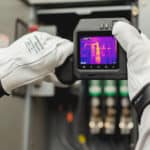As the person in charge of electrical safety, it’s key for you to know about arc flash risk, especially during equipment servicing. Remember, arc flash labels are more than warnings; they’re vital for keeping everyone safe, as per NFPA 70E standards. Your primary role is to ensure everyone follows these safety procedures to prevent injuries. Stay safe out there!
What Are Arc Flash Labels?
Arc flash labels are a clear warning for your team to identify high-risk equipment. According to NFPA 70E, arc flash labels are more than just caution signs; they also teach your employees about safe practices. Your main job is ensuring everyone is kept out of harm’s way.
Mandatory Arc Flash Label Requirements
NFPA 70E includes important arc flash label guidelines for keeping your team safe. You need your employees to understand the risks associated with the equipment they work with and the safety measures. By displaying clear arc flash labels at your facility, you reduce the risk of accidents, keeping everyone safe.
- Warning or Danger: Arc warning labels must draw attention. The label header should be in large letters to indicate the risk. The header should indicate an arc flash danger if the equipment voltage exceeds 600 or the incident energy exceeds 40cal/cm2. For lower levels, the header will indicate an arc flash warning.
- System Voltage: The label must indicate the system voltage, for example, 480 VAC or 208 VAC.
- Arc Flash Boundary: Your facility can estimate the range of an arc flash based on the voltage of electrified equipment. An arc flash label must indicate a safe zone for workers; however, a discharge may still injure employees outside the arc flash boundary. The safe zone shows the distance at which unprotected employees will not receive permanent injuries.
- PPE Category: Arc flash labeling must indicate one of two types of information. The first option is the level of personal protective equipment (PPE) necessary to reduce the risk of injury. Low levels may require wearing a long-sleeved shirt and pants to minimize skin exposure. Higher levels of risk will require the need for full flash suits.
- Incident Energy: The other option to meet arc flash label requirements is to list the incident energy of the equipment. This measurement is a rating of the potential energy release of an arc flash. The incident energy is calculated during an Arc Flash system study. PPE manufacturers base their equipment ratings on the incident energy they can withstand.
Optional for Arc Flash Label:
- Shock Protection Information: Besides the flash boundary, arc flash labels may list boundaries for shock prevention. The limited approach boundary shows the distance at which an electrical shock risk exists. The restricted approach boundary increases shock risk, especially for unprotected employees.
Who Is Responsible for Arc Flash Labeling?
SEAM Group understands that smaller facilities often face challenges finding time for arc flash labeling. It’s important to remember that NFPA 70E clearly states even if contractors handle your electrical services, the responsibility for labeling still lies with you. That’s why it is essential to find a contractor that you trust. SEAM Group is here to help you navigate this responsibility and ensure a safe environment for everyone.
Arc Flash Warning Labels as Part of a Larger Safety Strategy
Arc flash labels are just one piece of an overall electrical safety strategy outlined by NFPA 70E. If your facility includes electrical assets, adopting a well-rounded approach to prevent electrical shocks and arc flashes is essential. A helpful tip is to list the required PPE in arc flash zones and have it readily available. Remember, you’re not alone in maintaining your employees’ electrical safety; SEAM Group is here to help!





